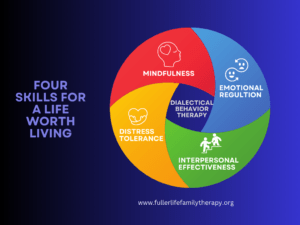10 Ways Your (Mis)Perceptions of Therapy Are Holding You Back
Are you getting the most out of your therapy sessions?
An important component of effective therapy is understanding how therapy is supposed to work. Unfortunately, many people hold misperceptions about therapy that prevent them from fully benefiting from its potential. From confusing it with education or coaching to falling prey to common clichés, these misunderstandings can leave individuals feeling unfulfilled and dissatisfied with the therapeutic process.
Therapy holds the power to transform lives. By unraveling these misconceptions, the true potential of therapy—a unique relationship engineered to catalyze meaningful change according to specific needs and desires—can be unlocked.
These 10 shifts in understanding the potential of effective therapy can make all the difference in a more meaningful and impactful therapy experience.
Shift #1
From a Safe Space to a Growth Space: Developing Resilience and Self-Compassion.
Therapy is not just a safe place. It’s about creating room for growth and change. While therapy does offer a secure environment, its primary role is to be a catalyst for personal growth. Growth occurs at the edge of our comfort zone, which doesn’t always feel “safe.” Additionally, effective therapy helps you move toward your pain, which may bring discomfort and fear.
Therapy can be a “safe” space to explore critical life challenges, but therapy and the therapeutic relationship are primarily about growth in a way that facilitates resilience, self-compassion, and motivates one to a more empowered life.


Shift #2
From Empathy to Compassion: Exploring Deeper Self-Awareness
Effective therapy goes beyond empathy to compassion in a way that helps a client(s) move toward what is true. Change is difficult for all of us, and an effective therapist is skilled at helping us move through our defenses and the ways we can self-sabotage. This process involves more than just understanding and reflecting on the clients’ feelings; it’s about guiding them toward a deeper self-awareness and acceptance.
A therapist who helps a client move toward what is true with an honest, yet compassionate approach is a therapist who cares more about their client than about continued business. This means that sometimes a therapist cares enough to say something that might be challenging to hear but has the potential to facilitate the most significant change.
SHIFT #3
From Reducing to Tolerating Emotions: Building Emotional Resilience
Clients often come to therapy expressing their desire to no longer feel scared or anxious. However, therapy works best when the focus is not solely on reducing the difficult feeling; rather, it focuses on building tolerance and resilience with these challenging emotions. Through therapy, clients grow to understand and manage their emotions effectively, thereby fostering emotional strength to confront life’s challenges.
Oftentimes the things that create challenging emotions are related to people or things that matter to us. For example, if a mom is struggling with worry about her child, it would be unrealistic for a mother to not worry, so therapy would support the mom in facing the worry so she can navigate the feelings better.
Therapy is not about feeling better;
it’s about getting better at feeling.

Shift #4
From External Validation to Self-Validation: Fostering a Strong Flexible Self
Therapy is more than a place to have someone validate your feelings, rather, therapy is a place where one can learn to validate and name their feelings in a way that will strengthen self-respect.
When a therapist repeatedly validates the client, they steal the client’s opportunity to learn how to find their voice of affirmation for themselves. This process fosters self-validation, empowering clients to know themselves, their thoughts, emotions, and what is important to them, potentially cultivating a strong sense of self.
SHIFT #5
From Learning Tools to Self-understanding: Cultivating Lasting Change
Effective therapy goes far beyond just learning coping tools; it’s about developing deep personal self-understanding that creates higher functioning and lasting change.
Many people think going to therapy is about learning coping skills, but therapy is not education. Effective therapy is a highly customized approach to self-understanding at a personal level. When we can see and understand our patterns and processes or those of our family members, we then have an opportunity to make different choices.
While it’s not uncommon to learn techniques for living more mindfully in therapy, this is not the focus of therapy. Learning skills for self-management can be learned from a book or a podcast, but coming to see your unique patterns or process cannot be read in a book. This is the gift of the therapist. A skilled therapist can help the clients see in a way that promotes self-understanding, self-compassion, and ultimately better ways of relating to self and others.
SHIFT #6
From Basic Ethics to Integrity-Driven Practice
Effective therapy extends way beyond adhering to ethical standards; it should be driven by the personal integrity of the therapist. A mental health professional is bound by an ethical code to not harm the client. However, this is the basic and minimal standard. An effective therapist will be driven by personal integrity more than clinical ethics.
There’s a phrase we use in training therapists called “the person of the therapist.” We don’t have the luxury of medication or a scalpel to move our patients to health. Therefore, a therapist must do their “person of the therapist” work. This is an ongoing process of self-care, self-confrontation, facing our fears, and having the courage to practice what we preach. This often requires the therapist spends significant time on the other side of the couch.
Shift #7
From Finding the Right Fit to Building a Collaborative Alliance
While a client may feel more comfortable with a particular type of person or therapeutic model, this is not the most important ingredient of effective therapy. We work to establish what we call a “therapeutic alliance” or a “collaborative relationship.” A collaborative relationship is essential; as the therapist and client(s) work together toward common goals with mutual understanding and agreement.

A strong alliance means we are working together with our client(s) throughout the course of therapy. One important component of this is being able to talk about the therapy itself and how the process is going. Sometimes clients drop out of therapy or find a new therapist when they are frustrated or disappointed with the process. This is a time to talk about what’s happening in therapy and hopefully strengthen the alliance. Even when the client opts to discontinue or seek a different therapist, most therapists really appreciate feedback about the client’s experience.
Shift #8
From Venting Emotions to Confronting Yourself: Facilitating Personal Growth
It’s not uncommon for a client to present for counseling and feel the need to vent about a concerning thing or experience. Often this alone is quite helpful to the client as many people rarely have the experience of being listened to well. Empathic listening where someone tracks what you are saying and reflects it to you feels nice and sometimes provides a sense of relief. However, venting alone rarely leads to resolution.
To change or heal deep-seated patterns, it is necessary to go deeper than just telling the story. This looks like a client being willing to really look at their own experiences, “process” or move through the pain or shame that has clouded that experience or concern for so long, and face themselves with kindness and compassion. This may then give them the chance to create a freer way of living and change that lasts.
Therapy is not designed for just venting and unloading stress. It’s an opportunity for clients to process their experiences, confront themselves, and meet their pain with compassion. This facilitates personal growth and the development of higher levels of functioning through self-reflection and understanding.
Shift #9
From Talking About Feelings to Processing for Healing
Discussing feelings is a part of therapy, but its core lies in processing these emotions, memories, and experiences in a way that is healing. Often this looks like “sitting with” something or reflecting on what’s happening in your body as you turn toward the things that’s hard. This deeper exploration paves the way for emotional healing, allowing clients to navigate through their complexities toward a fuller life.
Shift #10
From Seeking Advice to Cultivating Self-Connection
Providing advice undermines effective listening. Sometimes clients anticipate the therapist has all the answers and will tell the client what to do. While some therapists do give advice and it can be helpful; it’s usually more helpful to engage the client in self-direction based on an integrated connection with themselves. This self-connection guides clients in making decisions that align with their values and personal goals, fostering a sense of autonomy and informed decision-making.
Transform your life with effective therapy
The transformative power of effective therapy and its potential are clear. By embracing these shifts, individuals can unlock the full spectrum of therapeutic benefits, embarking on a journey of profound personal transformation.
Are you ready to challenge your existing perceptions and explore how you can harness the power of therapy to its fullest extent? The journey begins with a simple step—if you have a therapist, start a conversation about these transformative shifts. If you’re not already in therapy, consider taking that first step toward deep, meaningful change.
Therapy is more than venting, being validated, or feeling better—it’s about transformation. It’s about confronting yourself, healing, and emerging stronger. And it works! Check out our therapy outcomes.
Are you ready to embark on that journey?
clinical director
Amy Fuller PhD, LMFT-S, LPC-S, CST-S
Dr. Fuller is the founder and clinical director at Fuller Life Family Therapy Institute in Houston, Texas.










